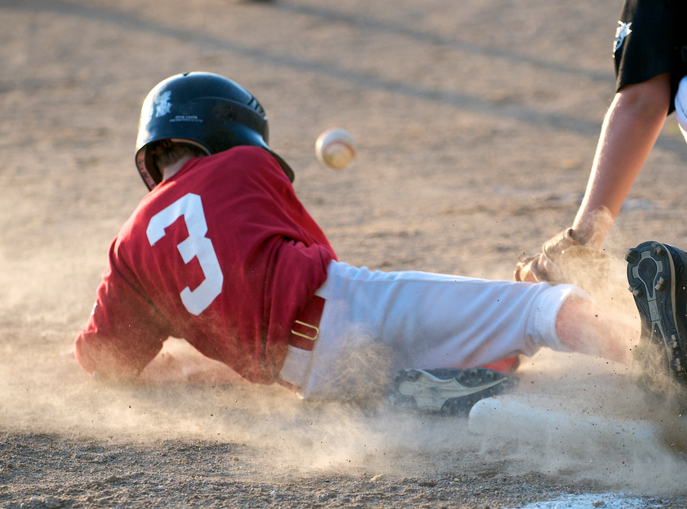
Once a batter becomes a runner, he/she is said to be “on” that base until attempting to advance to the next base, until he/she is put out, or until the half-inning ends. Runners on second or third base are considered to be in scoring position since ordinary hits, even singles, will often score them.
Whether swinging or bunting, when you are batting, always be prepared to break for first base as soon as your bat meets the ball. Experienced batters don’t stand around waiting to see if a hit will be fair or foul or caught by a fielder. Your immediate move toward first may make the difference between earning a base hit or being put out. You do not have to wait for the next hit before advancing. You can attempt to “steal” the next base at almost any time. The most important thing you can do as a runner is to watch the pitcher and try for a steal when the pitcher is committed to a pitch.
First base is the only base that can be overrun and returned to without jeopardy—as long as you do not head for second. On a one-base hit, you should run at full speed across first base, slow down, turn to the right (away from the base), and walk back to take your base. Once you’ve taken a base and the pitcher again has the ball, the next batter is up. Now, you should take a lead of several steps toward the next base. You will be much closer if the next batter makes a hit. But, you should not get much farther away from the bag than your own height. This will allow you to return easily to the base if the pitcher attempts to put you out.
You do not have to wait for the next hit before advancing. You can attempt to “steal” the next base at almost any time. The most important thing you can do as a runner is to watch the pitcher and try for a steal when the pitcher is committed to a pitch.
On a close play after a hit or on an attempted steal, you may have to slide into a base to avoid a tag. Two types of slides are generally used. The first slide is the straight-in slide. As you near the base, pull up one leg, extend the other leg almost straight forward, and drop to the ground, bent forward at the waist. Slide on the leg tucked underneath you and hit the base with your forward foot. The other type of slide is the hook, or fall away. This type of slide is generally used to avoid a tag when you arrive at base at the same time as the ball. In this move, slide past the base on the hip of your tucked-under leg and hook the corner of the bag with the foot of that leg.
Occasionally you may belly flop and slide head first into a base. However, this method is dangerous and should be avoided.
There are many rules that govern a runner.
| 1 |
When the ball is alive, the following rules apply.
|
| 2 |
If a runner is not forced, but could have simply held a base, the runner must be tagged out on the body while off base. |
| 3 |
A runner who overruns first base may not be tagged out. The runner overrunning or oversliding second or third may be put out. |
| 4 |
A runner may be called out if a fair ball touches the runner before a fielder has a chance to make a play on it. |
| 5 |
Runners who intentionally interfere with a thrown ball or with a fielder are called out. |
| 6 |
Runners may not leave the base lines, or they’re out. |
| 7 |
The runner will be out if, to get away from a tag, he runs more than three feet away from the line between the bases. |
| 8 |
If a base runner passes a forward runner who is not out, the passing runner is out. |
| 9 |
Any runner is out if hit by a batted ball. The runner is also out if the runner leaves a base before a fly ball is caught and fails to return before the ball is delivered to that base. |
| 10 |
A player who replaces a baserunner is called a pinch runner. |
